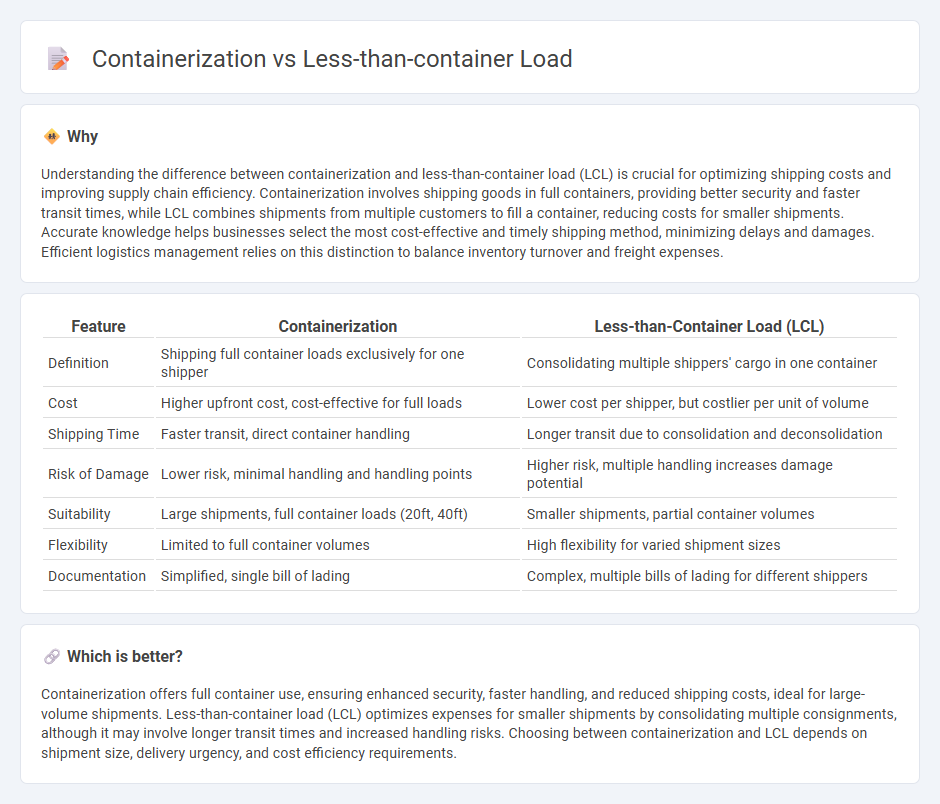
Containerization revolutionizes logistics by enabling entire containers to be shipped securely and efficiently, minimizing handling and reducing transit times. Less-than-container load (LCL) optimizes cargo space by combining smaller shipments from multiple customers, which reduces costs for those who do not have enough goods to fill a full container. Explore more to understand which shipping method best suits your supply chain needs.
Why it is important
Understanding the difference between containerization and less-than-container load (LCL) is crucial for optimizing shipping costs and improving supply chain efficiency. Containerization involves shipping goods in full containers, providing better security and faster transit times, while LCL combines shipments from multiple customers to fill a container, reducing costs for smaller shipments. Accurate knowledge helps businesses select the most cost-effective and timely shipping method, minimizing delays and damages. Efficient logistics management relies on this distinction to balance inventory turnover and freight expenses.
Comparison Table
| Feature | Containerization | Less-than-Container Load (LCL) |
|---|---|---|
| Definition | Shipping full container loads exclusively for one shipper | Consolidating multiple shippers' cargo in one container |
| Cost | Higher upfront cost, cost-effective for full loads | Lower cost per shipper, but costlier per unit of volume |
| Shipping Time | Faster transit, direct container handling | Longer transit due to consolidation and deconsolidation |
| Risk of Damage | Lower risk, minimal handling and handling points | Higher risk, multiple handling increases damage potential |
| Suitability | Large shipments, full container loads (20ft, 40ft) | Smaller shipments, partial container volumes |
| Flexibility | Limited to full container volumes | High flexibility for varied shipment sizes |
| Documentation | Simplified, single bill of lading | Complex, multiple bills of lading for different shippers |
Which is better?
Containerization offers full container use, ensuring enhanced security, faster handling, and reduced shipping costs, ideal for large-volume shipments. Less-than-container load (LCL) optimizes expenses for smaller shipments by consolidating multiple consignments, although it may involve longer transit times and increased handling risks. Choosing between containerization and LCL depends on shipment size, delivery urgency, and cost efficiency requirements.
Connection
Containerization revolutionizes global logistics by standardizing cargo transport, enabling efficient handling of Less-Than-Container Load (LCL) shipments. LCL consolidates smaller freight from multiple shippers into a single container, optimizing container space usage and reducing costs. This integration enhances supply chain flexibility, minimizes transit times, and improves overall shipping reliability.
Key Terms
Consolidation
Less-than-container load (LCL) shipping optimizes freight consolidation by combining multiple smaller shipments into a single container, lowering costs and improving efficiency compared to full container load (FCL) shipping. Containerization standardizes cargo transport through uniform containers, facilitating easier handling, improved security, and minimized damage during transit. Explore how strategic consolidation in LCL enhances supply chain management and cost-effectiveness.
Freight Forwarder
Less-than-container load (LCL) shipping optimizes freight forwarders' ability to consolidate multiple smaller shipments into a single container, reducing costs and improving efficiency for clients who do not require full container loads. Containerization streamlines the transport process by securing goods within standardized containers, ensuring protection and seamless handling across various transport modes. Explore how freight forwarders leverage both methods to offer tailored, cost-effective logistics solutions.
Intermodal Transport
Less-than-container load (LCL) optimizes intermodal transport by allowing multiple shippers to share container space, reducing costs and improving shipment flexibility. Containerization streamlines the transfer process across ships, trucks, and trains by using standardized containers, enhancing cargo security and handling efficiency. Explore detailed insights on intermodal transport advantages with LCL and containerization to optimize your supply chain.
Source and External Links
Less-than-container load (LCL) Definition - UPS - LCL means goods from multiple parties are consolidated in one container, making it cheaper than full-container-load shipping when shipment size doesn't fill a whole container.
How and When To Ship LCL (2024) - Shopify - LCL shipping allows a shipper to book only a portion of a shipping container, consolidating cargo with others to reduce costs and is handled via container freight stations for loading and unloading.
What is less than container load? - Container xChange - LCL refers to shipping volumes smaller than a full container load, often consolidated with other shipments for efficient delivery by sea, truck, rail, or air freight.
 dowidth.com
dowidth.com